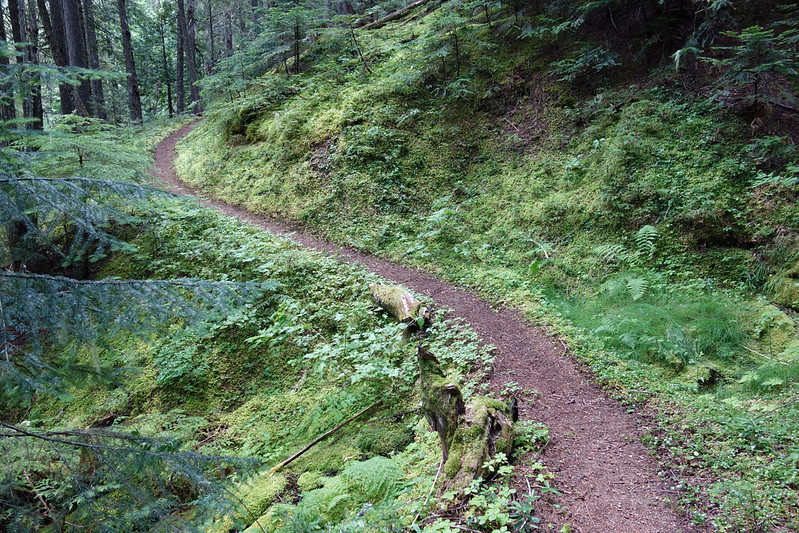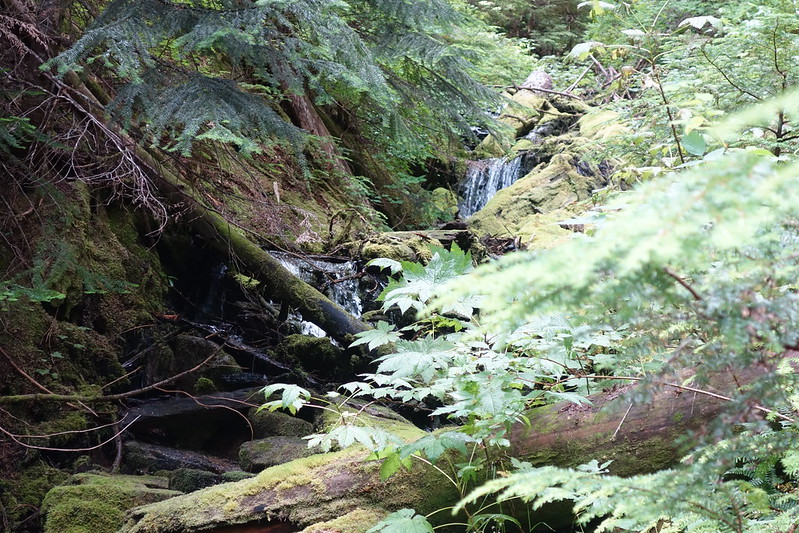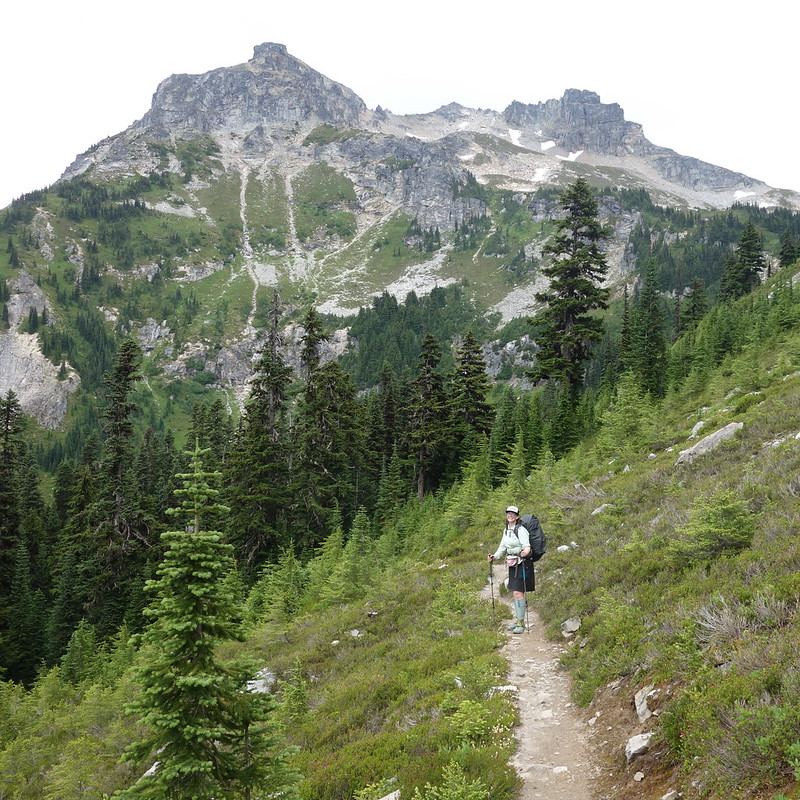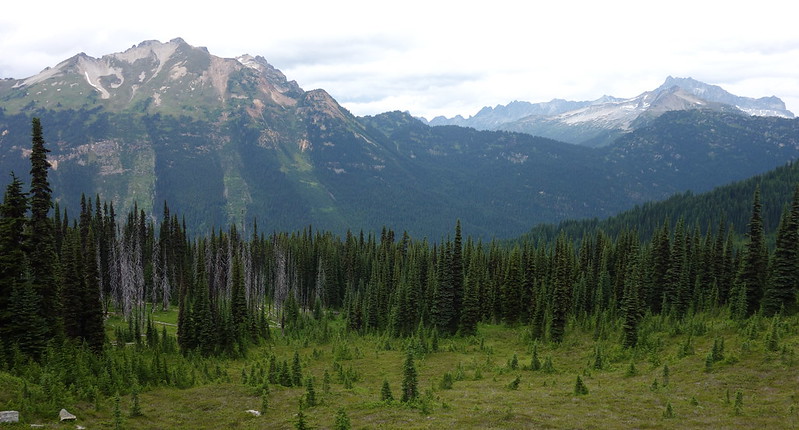August 2, 2019
Miner’s Creek to Small Creek
PCT, Miner’s Ridge, Buck Creek Pass Trail
1.
I slept last night with the stars, and without my rainfly. But I wake with a wet forehead to the sound of water hitting the ground. It’s raining. Very big drops. So I rush around, packing up my quilt and pad and tent and talking at Krista, who’s still happily asleep in her waterproof tarp. Or, at least: she was happily asleep until I started bugging her.
2.
The rain stops while the ground is still just flecked with wet, and we start up Miner’s Ridge in something almost like sun. Well, sun mixed with cloud and fog. Every season all at once. It feels like this—this mix of drops of remaining rain in the trees and shining green on the ground and everywhere stark lines of light—is somehow the ridge’s natural condition.
3.
As the PCT switchbacks up the ridge, I think about the wilderness here that almost wasn’t.
Early in the 20th Century, seventeen mining claims were patented for copper deposits just west of where we are now. The claims were huge: in total a bit over 500 patented acres and 3000 addition acres of unpatented starts.
For fifty years, access issues prevented any of the claims from being meaningfully developed beyond a few crude cabins, but the encroachment of logging roads into the Suiattle Valley in the 1950s made open-pit strip mines a real possibility.
In the early 1960s, Kennecott Copper, which had consolidated ownership for most of the patented claims on Miner’s Ridge, proposed a half-mile long strip mine near Plummer Mountain, a bit west of where the PCT crosses the divide at Suiattle Pass. At the time, the wilderness movement was still in its infancy, but several groups—principally the Sierra Club and the nascent North Cascades Conservation Council (NC3)—came together to oppose the move. The Sierra Club, led by David Brower, bought ads in The New York Times and several other national papers, chastising Kennecott for threatening “an open pit visible from the moon.” Supreme Court Justice William O. Douglas, working with the Club, led hikes up the Suiattle to show people what was at stake. And NC3, led largely by Harvey Manning—later famed for his hiking guides—fought a ground war against corporate interests, waging battles in junior high gyms and local chambers of commerce. At one meeting, Manning chastised the Executive Director of the Bellingham Chamber of Commerce so intensely that the man eventually had an emotional breakdown, and admitted that his public statements on the matter had been wholly written by the Puget Sound Pulp and Timber Company.
The Sierra Club and NC3 initially attempted to head-off mining here by including Glacier Peak in the then-proposed North Cascades National Park, but strong industry lobbying prevented the Park from extending south much beyond the Stehekin River. Instead, after a long fight with the Forest Service over boundaries, the groups won a partial victory with the declaration of the Glacier Peak Wilderness—the wilderness that we’ve been walking through for the last week. The new wilderness effectively halted logging in the Suiattle Valley, and, perhaps more importantly for present purposes, it also stopped any new roads from being built in the area, making mining in the wilderness unprofitably expensive. But the wilderness declaration did not entirely foreclose the possibility of future mining, as it allowed both existing claims in the area to proceed unrestrained and new claims to be patented until 1983. If copper got expensive enough, or roadless extraction got cheap enough, it would be in Kennecott’s interest to make mining work, lack of roads notwithstanding.
Kennecott held onto its mines here until the mid-80s, but, after a decade of collapsing copper prices, it sold them to the Chelan Public Utility District, which planned to use the land as a snow depth monitoring site. But the area was not permanently saved from mining until 2010, when the Wild Sky Wilderness Act facilitated a land-swap: the Forest Service acquired the old mining claims from Chelan PUD as a conservation easement, and in exchange the Forest Service gave Chelan PUD for a much smaller, 1.8 acre remote snow telemetry site and permission to land helicopters there a few times a year.
4.
The story of Glacier Peak’s mines mirrors the more general story of mining in American wilderness. Under the 1964 Wilderness Act, no new mining patents have been issued in statutory wilderness since 1983, but pre-83 claims are, at least in principle, allowed to proceed unrestrained. But the de jure right to mine in wilderness has proven, de facto, impossible to exercise, as widespread public condemnation of proposed projects has halted all but a few operations before they can begin. After the incident on Miner’s Ridge, Kennecott became a punchline, and most companies have given up their wilderness claims without a fight rather than face public embarrassment.
5.
The clouds lift further as we climb up the ridge. Two ultrarunners pass, shouting happy hellos. Then we pass a solo woman, out for a week from Stevens to Stehekin. “It’s so incredible out here.”
We stop at the Buck Creek Pass Trail junction for a snack, and watch several large groups—mostly young guys with huge packs and fishing poles—turn up the trail, all midway through the Spider Gap – Buck Creek Pass Loop.
As we’re packing up to go, we meet a slightly older Irish guy, who’s been hiking north on the PCT since Crater Lake. He tells us about hiking the trail last year. He started in Campo with his wife, intent on doing the whole thing together. They had an enchanted walk through the desert, made it through the deep Sierra snow and thick northern Californian mosquitoes. But then, in Crater Lake, “she got sick.” That’s all he says. “She got sick.” She got sick and never made it home. “So, I’m finishing it this year, alone.” His eyes look heavy. I have absolutely no idea what to say. My eyes feel heavy too.
I try to stay cheerful for the rest of our talk, but tear up as I watch him walk away—watch his mud-soaked legs and tattered old green raincoat. I wonder if it’s the coat he wore last year, before she got sick. I look over at Krista and her eyes are wet too. We sit back down for a bit, together.
6.
The Buck Creek Pass Trail leaves the PCT a couple miles before of Suiattle Pass, then climbs a few thousand steep feet along a minor fork of Miner’s Creek to Middle Ridge—a forested finger that stretches west from Fortress Mountain down to the Suiattle.
As we climb, I think again of the abandoned mines just down the ridge. Most of the old cabins there have fallen over, as has the ancient infrastructure. But near the center of what would have been Kennecott’s strip mine, at the western edge of a blooming meadow full of trickling streams, there’s a well-preserved old bench. The bench’s placement is curious—the ground’s a little loamy and the whole place a little damp—and one wonders why they didn’t place the thing a few dozen feet forward, in the meadowed sun. It’s curious until one looks up to see the view that the bench’s placement affords of Plummer Mountain, here as towering and extraordinary as Glacier Peak itself, or indeed as any of the Cascades. One imagines grizzled old miners a century ago sitting on that bench after long days at work, watching sunsets filter through the hills.
7.
The image makes me think of this small, beautiful book I read a while ago about the role of public lands in American history. The idea is that, despite contemporary political narratives to the contrary, public lands have historically exerted a sort of centripetal force in American politics, bringing otherwise diverse groups together in protection and celebration of a common heritage.
The perhaps paradigm case here is the birth of the National Parks system itself. At the beginning, when Lincoln declared Yosemite to be a national preserve in 1864, Americans were still dying in the Civil War. And from the outset he understood the nascent work of preserving American landscapes to be tied up with the coming work of reconciling Americans with each other. When the war was won the next year, the National Gallery shifted from displaying photographs about the ravages of war—photos of burned buildings and dead soldiers in ditches—to an exhibit on Yosemite’s natural splendor, photos of falls and endless granite fields and trees bigger than anyone on the east coast had ever seen. The idea was that, if shown the grandeur of the land they had no choice but to share, Americans might also come to imagine the possibility of together building a common life worthy of that land.
That was naïve, of course, but, thinking of that bench at the edge of the meadow, I wonder if there’s also the start of something there. Maybe an appreciation of the world we already share is not a sufficient foundation for building a common life—civilization requires more than sitting together to watch the sunset—but I wonder if appreciating the contours that world might be a precondition for building more together.
8.
We reach the top of Middle Ridge in a light drizzle and stop for lunch at an overgrown camp nestled into a small grove of windswept alders. Then we follow the muddy trail down a thousand feet and across a couple sketchy stream-crossings to a set of beautiful camps hacked into the hillside above Small Creek, where we set up quickly against the rain.
Small Creek, it turns out, is actually a medium-sized river, and we spend the afternoon and evening playing along its banks, doing all the last night things: eating all the random things in the bottoms of our food bags, drinking the last of the bourbon, looking through all the pictures we’ve taken. Taking turns leaning on our heads on the other’s shoulder.
9.
Krista takes a quick pre-dinner nap, and I get to thinking, one last time, about the fight for Miner’s Ridge, and about David Brower, the man who led that fight for the Sierra Club. Brower was famous for arguing that wilderness, just by existing, made the world a better place. Walking through the soon-to-be statutory wilderness here with John McPhee, he explained the logic as follows:
I have a friend… who wears leg braces. I have heard him say that he would not want to come to a place like this by road, and that it is enough for him just to know that these mountains exist as they are, and he hopes that they will be like this in the future.
Brower framed his belief as a sort of anti-anthropocentrism. “I believe,” he later told McPhee, “in wilderness for itself alone.” Brower’s critics framed this as a sort of anti-humanism, and Brower himself as a “modern druid,” who “worships trees and sacrifices human beings to those trees.”
But I’m not sure that’s right. Brower’s claim is that wilderness is intrinsically valuable—that, just by existing, it adds value to the world. But notice that that’s not actually what his story about the leg-braced friend illustrates.
The old philosophical test for intrinsic value comes from GE Moore, whose “method of isolation” asks us to imagine a possible world in which the would-be intrinsically valuable thing is the only thing that exists. In this case, imagine a world with nothing in it but wilderness: no miners to muck things up, but also no one there to appreciate the untouched splendor—no humans or human-like creatures. It’s not clear that Brower would say that this isolated wilderness retains its value. His story is about a friend finding value in the knowledge that wilderness exists. Just the knowledge is enough. But there still must be someone capable of having that knowledge. Wilderness can only be valuable when there’s someone—a human, or perhaps another creature—capable of valuing it.
This is not just an academic point. Although he spoke of intrinsic value, Brower was ultimately interested in making the world better for people (and perhaps for other creatures capable of valuing in the way that people do). He was not an adherent of some bizarre anti-humanist cult; he just understood that there’s far more and varied value in the world than one can find copper, or in the coffers of some mining company. He knew that the worth of a shared sunset—even just a sunset we imagine sharing—is not measurable in dollars.
10.
Our own sunset tonight’s a muted affair—just a little filtered light on the small creek that’s really a river—but it’s magisterial in its own way. And our evening feels much the same. We boil our little dinners, take a small stroll, hang the food, and watch bats swoop along the west buttress of Fortress Mountain, catching mosquitoes.
How lucky we are to be here, and to have been here for a week of sunsets. How lucky to have gotten to see it separately, then together—to get to tell each other stories, and to have stories that we can tell together.
And how lucky we are that people had the foresight, more than fifty years ago now, to protect this place for us, for all of us. To protect its sunsets and skeeters, the deep valleys and fields full of marmots. The blooming ridges and frozen cols. The companionable riverside camps, where two scraggily hikers can spend a night as the richest folks in the world, together.











Wonderful! I have two hands, and I’m clapping them. Thanks for posting these, especially now.